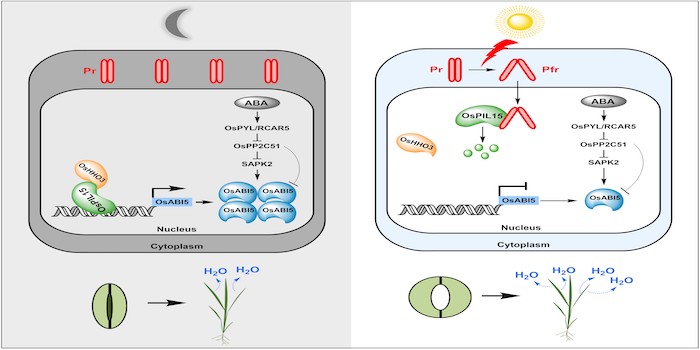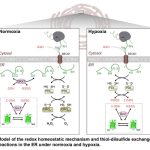OsPIL15 Regulates Stomatal Aperture by Coordinating Red Light and Abscisic Acid Signaling
Li et al. discover that OsPIL15 interacting with OsHHO3 forms the OsPIL15-OsHHO3 transcription factor complex to promote the binding of OsPIL15 to the promoter regions of OsABI5 and then reduce stomatal aperture through the ABA signaling pathway https://doi.org/10.1093/plcell/koac244
By Qian Li and Luyan Zhou
Background: Plants typically respond to environmental changes by changing the width of the stomatal pore (stomatal aperture), via stomatal movement. Stomatal movement is a key physiological process coordinating CO2 uptake for photosynthesis and water loss through transpiration. Blue and red light regulate stomatal aperture. The mechanism by which the blue-light photoreceptors cryptochromes (CRYs) and phototropins (PHOTs) mediated blue-light regulation of stomatal aperture has been studied extensively, but the pathway of red-light regulation of stomatal aperture mediated by red light photoreceptors phytochromes (Phys) remains unknown. Phytochrome-interacting factors (PIFs) can interact directly with Phys, and act as negative regulators of light responses. PIF and PIF-like (PIL) proteins are involved in plant growth and development and acts as a cellular signaling hub that integrates multiple signals to orchestrate the transcriptional regulatory network that drives multiple aspects of downstream morphogenesis. However, to date, limited information is available for a reliable understanding of PIFs’ role in regulating stomatal aperture.
Question: Is OsPIL15 involved in regulating stomatal aperture?What is the possible mechanism?
Findings: We discovered that the rice PIF family transcription factor OsPIL15 interacts with the NIGT1/HRS1/HHO family transcription factor OsHHO3 and promotes transcription of ABSCISIC ACID INSENSITIVE 5 (OsABI5). OsPIL15 is a key transcription factor regulating abscisic acid (ABA) signaling by binding to the PBE-box motif of the OsABI5 promoter and regulates stomatal aperture. Furthermore, we discovered that other rice PIF proteins are not involved in regulating stomatal aperture under red light or far-red light, except for OsPIL15. This suggested that the OsPIL15-regulated pathway of stomatal aperture in rice may be unique among PIF/PIL proteins in rice. However, the maize PIF family genes ZmPIF1 and ZmPIF3, homologous to OsPIL15, also negatively regulate stomatal aperture in maize, indicating that PIF-regulated stomatal aperture may be conserved in plants. Our findings explain the molecular mechanism by which PIFs play a role in red-light-mediated stomatal opening, and demonstrate that PIFs could regulate stomatal aperture by coordinating red light and ABA signaling.

Next steps: We are interested in investigating the roles of red light in regulating stomatal aperture, including possible mechanisms.
Reference:
Qian Li, Luyan Zhou, Yanan Chen, Ning Xiao, Dongping Zhang, Mengjiao Zhang, Wenguo Wang, Changquan Zhang, Anning Zhang, Hua Li, Jianmin Chen, Yong Gao (2022) Phytochrome Interacting Factor Regulates Stomatal Aperture by Coordinating Red Light and Abscisic Acid. https://doi.org/10.1093/plcell/koac244



